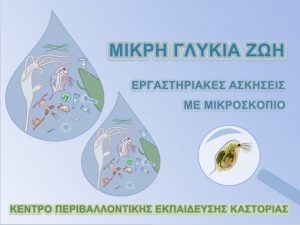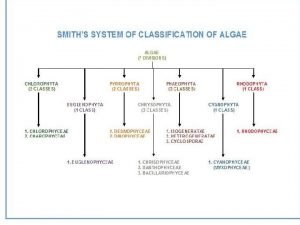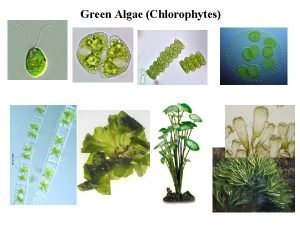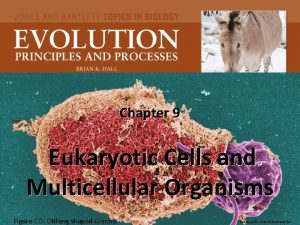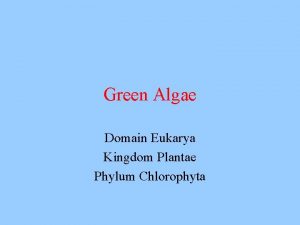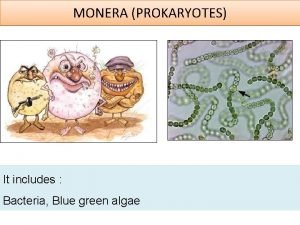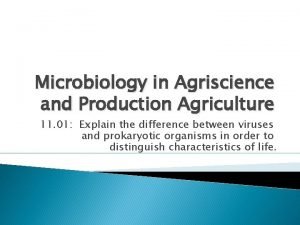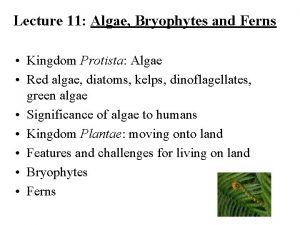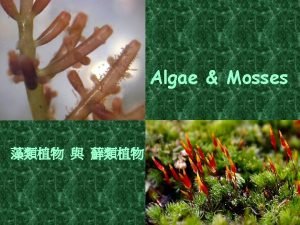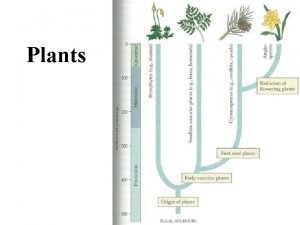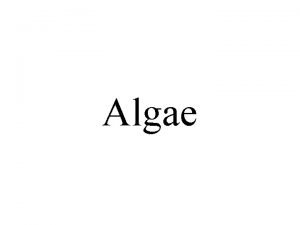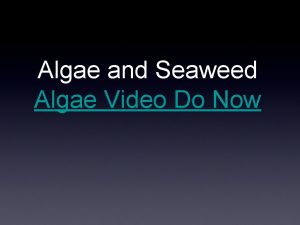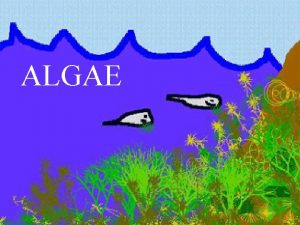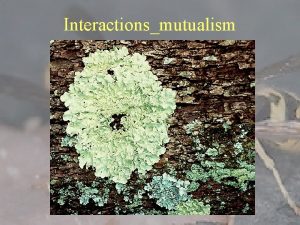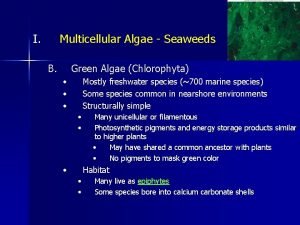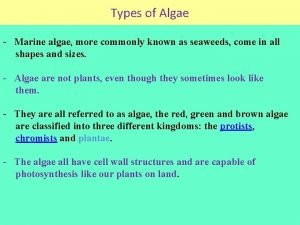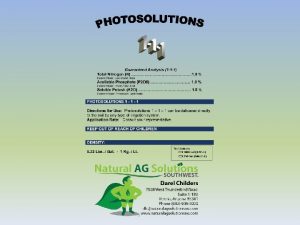General Features of Chlorophyceae Green Algae Chlorophyceae Green













- Slides: 13

General Features of Chlorophyceae (Green Algae)

Chlorophyceae (Green Algae) Ecology Nutrition Pigments Stored food Morphology Structure Reproduction Mostly fresh water forms, some are marine and few terrestrial Autotrophic (Photosynthetic) Chlorophyll a, b, beta-carotenes and xanthophylls Starch and Oil Unicellular (Chlamydomonas), colonial (Volvox), filamentous (Spirogyra), multicellular (Ulva) Cell wall is made of cellulose {inner side} and the outer layer is from pectose. The chloroplast may be discoid, cup-shaped, spiral or ribbon shaped in different species. Chloroplast may contain one or more storage bodies called pyrenoids (starch accumulation). Flagella: 1, 2, 4 to many, equal apical or subapical insertion Vegetative reproduction by fragmentation, tubers, cell division etc. Asexual reproduction by flagellated zoospores, aplanospores, hypnospore, autospores and palmella stage. Sexual reproduction may by isogamous (e. g. Chlamydomonas, Spirogyra), anisogamous (e. g. Chlamydomonas, Ulothrix) or oogamous (e. g. Chlamydomonas , Volvox, Chara).

Chlamydomonas General Characteristics: ØGreek words: Chlamyda = mantle, monas = single ØUnicellular, motile flagellates occurring in stagnant water and on damp soil, in freshwater, seawater, and even in snow as “snow algae” (C. nivalis). ØFound in habitat rich in nitrogen, ammonium salts & organic matter. ØNutrition: Most species are obligate phototrophs but C. reinhardtii and C. dysosmos are facultative heterotrophs that can grow in the dark in the presence of acetate as a carbon source.

General Characteristics: ØMotile, unicellular (single-celled), fresh water green algae. Ø The shape of thallus can be oval, spherical, oblong, ellipsoidal or pyriform. ØCell wall is smooth, thin and made up of cellulose fibrils. ØCytoplasm is present between the cell wall & chloroplast, and includes nucleus, mitochondria, ER, ribosomes etc. The single large, dark nucleus is enclosed in a cup-shaped chloroplast ØTwo anteriorly inserted whiplash flagella, equal in size (9+2 arrangement). Each flagellum originates from a basal granule or Blepharoplast. ØTwo Contractile vacuoles are located at the base of flagella. Function: Excretion or Osmoregulation. ØProminent cup or bowl shaped chloroplast is present. But the chloroplasts can be of various shapes in different Chlamydomonas species, For eg. ‘H’ shaped in C. bicilliata, reticulate in C. reticulata, parietal in C. mucicolastellate and axile in C. steinii.

ØThe chloroplast is generally associated with pyrenoid, but sometimes pyrenoids can be more than one. The pyrenoids are two in C. debaryana and many in C. gigantae. ØA single large storage body, Pyrenoid covered with starch plates is present in the posterior end of the chloroplast, where starch is formed from photosynthetic products. ØEye spot or Stigma, a tiny spot of orange or reddish colour is present in the anterior portion of the chloroplast. It consists of 2 -3, parallel rows of droplets or granules containing carotenoids. It is a Photoreceptive Organ (allowing the cell to swim towards light), concerned with the direction of movement of flagella.

Reproduction in Chlamydomonas I. Asexual Reproduction: a. By Zoospores: formed under favourable conditions and zoospore formation can takes place every 25 hrs. b. By Aplanospores: formed slightly under unfavorable conditions e. g. , in C. caudata. On approach of favourable conditions, aplanospores may germinate either directly or divide to produce zoospores. c. By Hypnospores: In extreme unfavorable conditions, the protoplast develops thick wall and the structure developed is called Hypnospore e. g. , in C. nivalis. The hypnospores also germinate like aplanospores on approach of favourable conditions. d. Palmella Stage: formed under unfavorable conditions as shortage of water, excess of salts etc. The protoplast of parent cell divides to make many daughter protoplasts but they do not form zoospores. These protoplast segments are called palmellospores. The division of these protoplast ultimately forms amorphous colony with indefinite number of spores and it is called palmella stage. When favourable conditions return, the gelatinous wall is dissolved, palmellospores develop flagella, and the spores are released to make new thalli.


Reproduction in Chlamydomonas II. Sexual Reproduction: a. Isogamy: In isogamous reproduction, the fusion of gametes, which are similar in size, shape and structure, take place. These gametes are morphologically similar but physiologically dissimilar. In many isogamous species, the vegetative cells may directly function as gametes without undergoing any division e. g. , in C. snowiae, this fusion is called as hologamy.

b. Anisogamy: In anisogamous reproduction, the gametes are unequal in size. The male gametes or microgametes are smaller, the female gametes or macrogametes are larger. The macrogametes are formed in female gametangium in which the protoplast divides to make 2 to 4 gametes only. The microgametes are formed in male gametangium, where the protoplast divides to make 8 -16 gametes.

c. Oogamy: The oogamous sexual reproduction takes place in C. coccifera and C. ooganum. The vegetative thallus functioning as female cell withdraws its flagella and directly functions as non-motile macrogamete or egg. The microgametes are formed by four divisions of protoplast as in case of anisogamous reproduction. The microgamete reaches the female gamete and contact wall between the two dissolves. After plasmogamy and karyogamy, a diploid zygote is formed. The zygote secretes a thick wall and transforms into zygospore.

Zygote/Zygospore Formation: The zygote is resting diploid spore and survives long period of unfavorable conditions. The zygote secretes a thick wall and accumulates large amount of oils and starch. The zygospores are red in colour due to the presence of haematochrome. When favourable conditions occur, the zygospore germinates. Its diploid nucleus divides by meiosis to make four haploid nuclei. The four daughter protoplasts, each with one haploid nucleus, form four haploid zoospores or meiozoospores. Each zoospore contains eye spot, two flagella and contractile vacuoles. In 4 zoospores, two may be of (+) type and two (-) type in heterothallic forms. Eg. , No. of meiospores per zygospore are 8 in C. reinhardtii or 16 -32 in C. inter-media


Thank You
 Chlorophyceae
Chlorophyceae Red green show
Red green show General characteristics of cyanobacteria
General characteristics of cyanobacteria Ulothrix
Ulothrix Stramenopila characteristics
Stramenopila characteristics Charophyta
Charophyta Algae domain
Algae domain Blue green algae bloom
Blue green algae bloom Monera blue green algae
Monera blue green algae Green algae prokaryotic or eukaryotic
Green algae prokaryotic or eukaryotic Ferns and algae kingdom
Ferns and algae kingdom Economic importance of algae in medicine
Economic importance of algae in medicine Green algae cell structure
Green algae cell structure Kobe kuiz
Kobe kuiz
